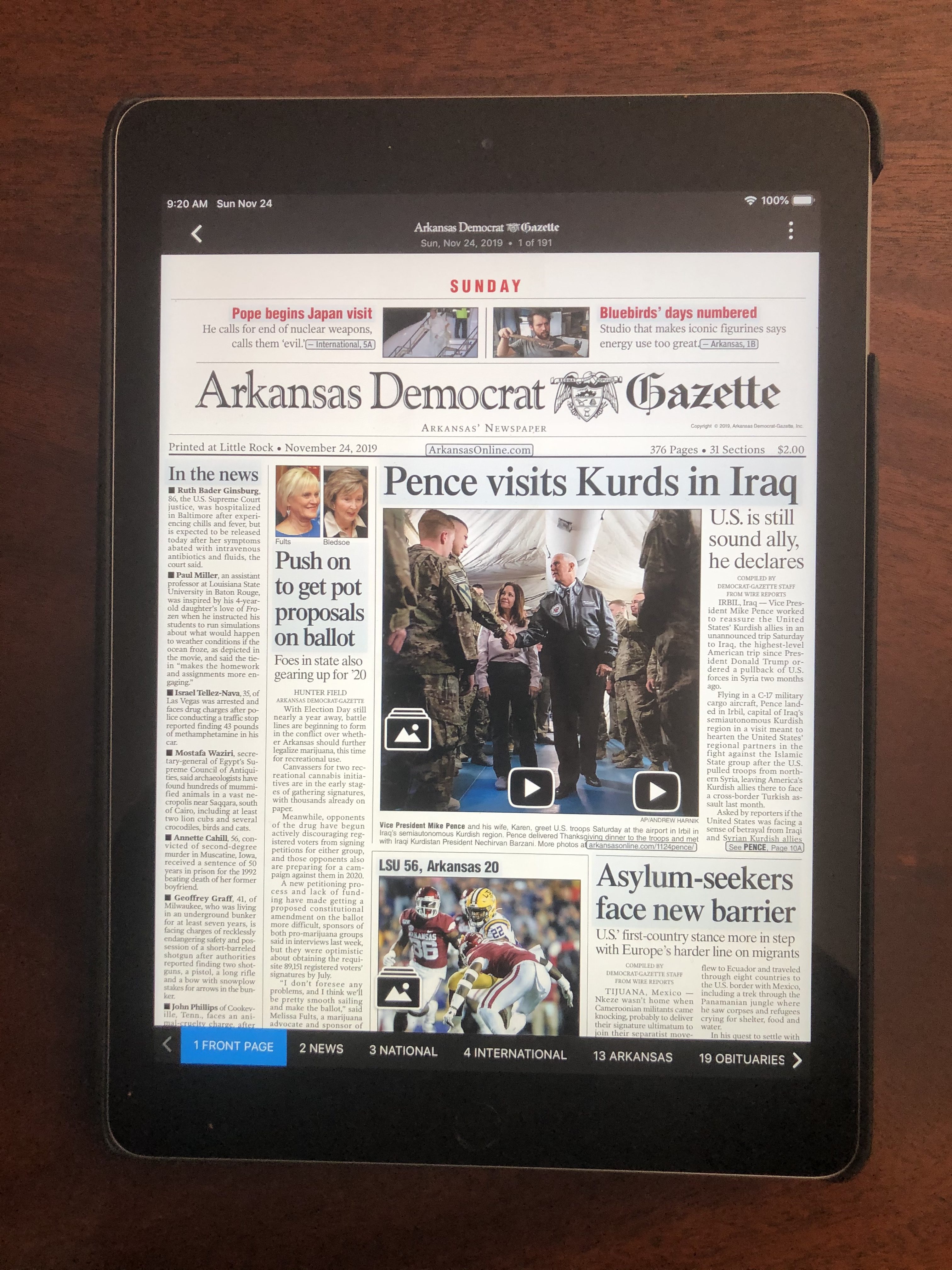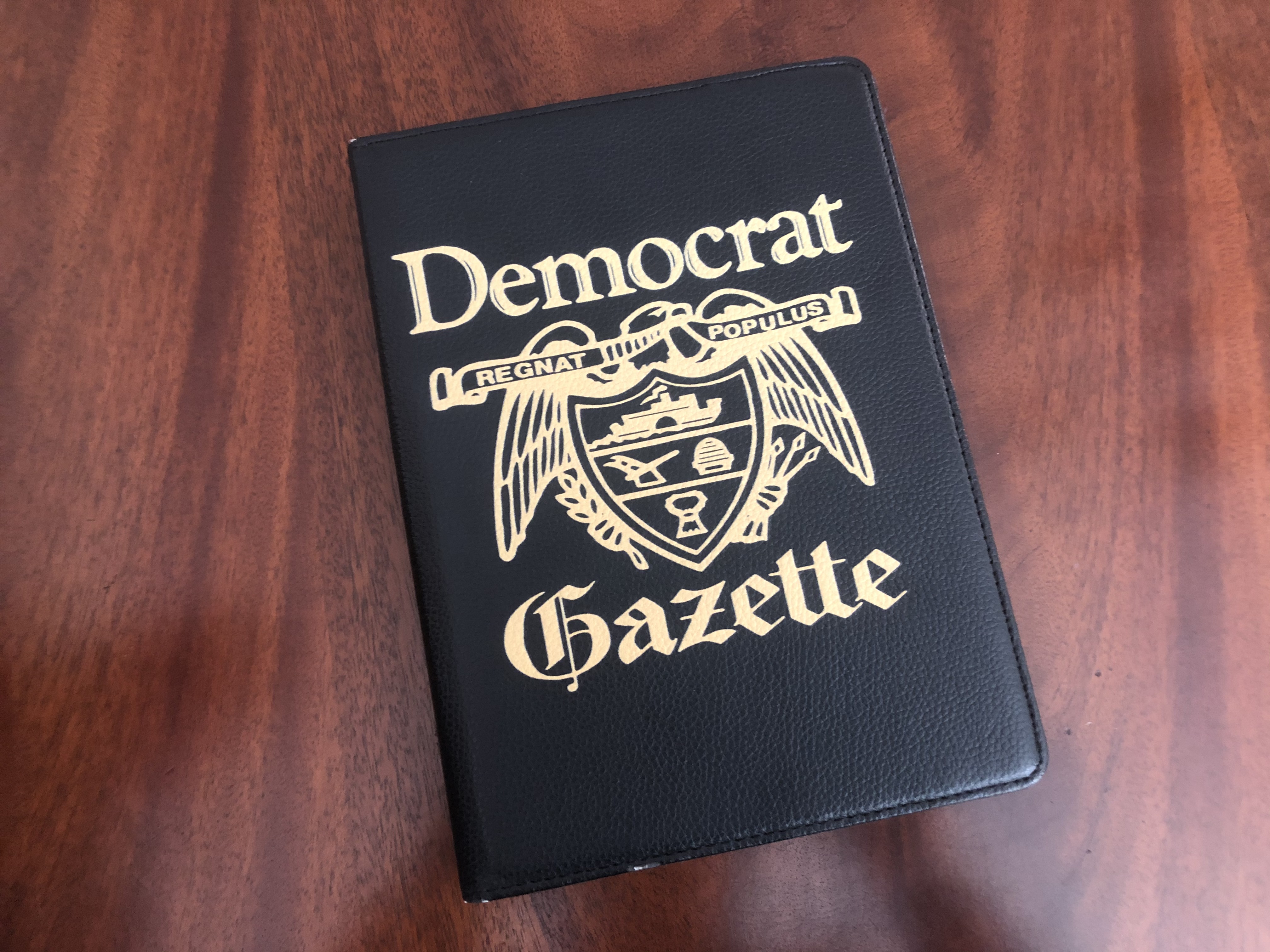This is an abridged version of an article on Northwestern University’s Medill Local News Initiative website. It can be read in its entirety here.
Walter E. Hussman Jr., publisher of the Arkansas Democrat-Gazette, is pioneering a bold strategy to transition readers from print to digital by taking away their daily newspaper cold turkey and giving them a tablet with a daily online replica that mimics the print edition.
Hussman’s experiment is make-or-break for the Democrat-Gazette. If successful, it may finally offer an effective way for news organizations to lure longtime loyal readers away from print editions that are expensive to produce and deliver. But if the strategy doesn’t work, Hussman knows his newspaper is in trouble. He felt he had no choice. “You know what’s going to happen if it doesn’t work? We’re going to eventually go out of business,” Hussman said. “Newspapers are not going to make it. In fact, you’re going to start seeing a lot of newspapers probably become weeklies and some of them just going out of business.”
Hussman, whose newspaper has distributed 27,000 iPads in the project, is encouraged by the results so far, with an over-all subscriber retention rate of 78 percent. The Democrat-Gazette is nearly done converting the Little Rock area, delivering a print newspaper only once a week – on Sundays – while lending subscribers an iPad for free so they can read a daily replica edition. As Hussman loses a modest fraction of his subscribers, he is banking on the idea that those who remain will be fully engaged. He is determined to “smother these people with customer service,” to truly move from ad-revenue dependency to a focus on the readers.
The Democrat-Gazette has been converting subscribers in outer areas of the state for about two years, testing a variety of offers. In Pulaski County, Arkansas’ most populous county and home to its biggest city, Little Rock, the conversion should be done by the end of January. That will leave only the state’s prosperous and growing northwest area unconverted because of a difficult subscription-rate issue there, but Hussman has a plan for that, too.
A key to Hussman’s strategy is not forcing the readers to make two jumps at the same time – from print to digital, and from a traditional newspaper layout to a far different online format. The replica looks like the print paper, except that readers click on the stories they want and see them displayed in an easier-to-read format. They get photos presented as they would be in a print edition, but if they click on them, they sometimes get access to an entire photo gallery or a video. But the key is: It looks like an old-fashioned newspaper.
“I think the big mistake newspapers made – and we made it too, you know – initially was trying to convert people to digital and then trying to change the format on them,” Hussman said. “… We said: Why do that? Let’s let them keep the format they’re familiar with, the format they love.”
Another attribute of the replica is that it’s a finite package of news. Last year, the Spiegel Research Center at Northwestern University’s Medill School of Journalism, Media, Integrated Marketing Communications unveiled a major analysis of subscribers’ behavior online and found, to its surprise, that people who read more stories were not more likely to keep their subscriptions. In some cases, they were less likely. Could the endless river of stories somehow be denying readers a sense of completion?
In contrast, a replica offers “a beginning and an end to the news,” Hussman said. “In other words, it’s always been that way with a printed newspaper. When you pick it up, even if you go from page to page, front to back, there’s an end. Often it seems like a website is endless.”
Jim Friedlich, Executive Director and CEO at the Philadelphia-based Lenfest Institute for Journalism, called the Democrat-Gazette’s tablet project “a hopeful sign that a major local publisher has been able to convert subscribers to digital at scale.”
“The question is: How replicable is this?” Friedlich said. “Is the Arkansas experience a unicorn or is it a repeatable experiment? My hunch is that it’s a bit of both, that with the right set of circumstances, this could be done elsewhere. In Arkansas the circumstances include a news product that has been well nurtured and well maintained over the years and not bled dry as we’ve seen in other markets, a newspaper that’s still highly regarded and has a loyal statewide readership, and a publisher who has himself deeply committed to this task and has put very significant personal energy and reputation behind it.”
Friedlich added: “I think he’s onto something and we should be watching pretty closely.”

Tablets have been tried before
The Democrat-Gazette is at the forefront of this tablet experiment, but it’s not a new idea to package tablets and subscriptions.
In 2011, the Philadelphia Media Network, owner of the Philadelphia Inquirer and Philadelphia Daily News, offered a deeply discounted tablet with a two-year digital subscription. The news organization predicted that the first 5,000 would sell in a week, but six weeks in, just half of that number had been sold. In addition, the effort was battered with criticism over customer service and other issues. That same year, there were media reports that Tribune Co., which owned the Los Angeles Times, Chicago Tribune and other papers, planned to offer subscribers a free tablet if they agreed to a two-year subscription. But Tribune never launched the offer.
Asked about other U.S. news organizations trying the experiment, Hussman cited only the Post and Courier in Charleston, South Carolina, which is conducting limited tests.
Hussman said the Post and Courier’s publisher, P.J. Browning, called him to ask about his tablet project, and he invited her to hear him talk about it at a Rotary Club meeting at a Western Sizzlin restaurant in Malvern, southwest of Little Rock. She went back to Charleston and started testing, with the replica “e-edition” supplemented by print delivery only on Wednesdays and Sundays.
“We are really early,” Browning said. “We completed one small route of 158 people and we are in the field right now with the next conversion of a similar amount to go live February 1.”
Hussman has long bucked conventional wisdom in the newspaper industry, and has often been right.
When his family’s business acquired the Arkansas Democrat in 1974, it was the down-market afternoon rival to the morning Arkansas Gazette, the oldest paper west of the Mississippi River and winner of two Pulitzer Prizes for its coverage of the 1957 school integration crisis. Hussman took the Democrat to mornings and refused to accept second-class status, dramatically raising subscription prices to match the Gazette’s against the advice of some of his own staff. He offered free classified ads and gave the paper a feisty opinion section featuring commentary by a managing editor who once posed for a photo crouched on a newspaper box with a knife between his teeth.
The Gazette was purchased by Gannett and the Democrat kept improving its market position, ultimately defeating Gannett, which sold the Gazette to the Democrat in a 1991 merger. It’s been called the Democrat-Gazette since then. Hussman put up his paywall in 2001, when hardly any daily newspapers were doing that, and saw its circulation hold steady from 2001 to 2011.

‘I even like getting the ink on my fingers’
Newspaper reading is a lifelong habit, and many people have been wary of the Democrat-Gazette’s change.
Hussman recalled a man standing up at the Stuttgart Rotary Club and saying that when he heard about the print-to-tablet conversion, “I was so depressed. I’ve been reading this newspaper for decades. I love it. I love having it. I love the tactile feel of the paper. I love holding it up right by my coffee. I love my dog going out to get the paper in the morning. I even like getting the ink on my fingers.”
That last point amused Hussman. “I thought to myself, boy, that’s the first time I’ve ever heard that.”
He said the man continued: “So I really hated this idea. But my wife said let’s go down and look at this iPad.” That was about three weeks ago, the man said, and “I’ve been using it every day. I cannot believe that I’m saying this: I actually like it better.”
The Democrat-Gazette wants its subscribers to become so attached to the iPad that it makes them more likely to stay as news consumers.
“We want people to love their iPads,” Hussman said. “We want them to not only read our paper. We want them to download books, create photo libraries on their iPad, watch movies. We want them to get really attached to this iPad. Because then somebody might say, ‘You know, I don’t read the paper as much as I used to. I think I’ll just drop it.’ And we’ll say, ‘Have you returned that iPad?’ Then they’ll say, ‘Return the iPad? I don’t want to return that iPad!’”
But Hussman is selling news, not iPads.
“We’ve got a newspaper with lineage going back 200 years,” he said. “If there’s any way to save it, we’ve got to try some way to save it. What they’re doing in Raleigh and Omaha and all these other towns is not going to save the newspaper.”
The Democrat-Gazette tried its first tablet experiment in early 2018 in Blytheville, a town in the northeast corner of the state that was an appropriate target because outlying circulation is often so costly. But its first attempt to knock on doors and persuade people to read the paper on the iPad failed. Then it tried to package conversion with the purchase of an AT&T cellphone and a deep discount on an iPad, and got just 4 of 200 subscribers. The third time, they decided to simply lend an iPad to subscribers for free.
“We decided to do one other thing that’s probably the key to the whole deal that we didn’t realize at the time,” Hussman said. “And that is, we’re going to smother these people with customer service, like they’ve probably never seen. … We’re going to actually show these people how to use their iPads. We’re not going to show them in a big group lesson. We’re going to show them one-on-one so we can answer all their individual questions and try to get them comfortable with doing this.”
That worked. They got 140 of 200 subscribers: 70 percent.
They kept going from town to town, and tried a new offer in South Arkansas: adding Sunday print to the package. That boosted the acceptance rate to 80 percent, Hussman said.
The results in Pulaski County have been especially closely watched.
“In southwest Little Rock … generally lower income, more Hispanic now … we got about 80 percent. But everywhere else in Pulaski County – we did it by zones around the county – we’re over 90 percent. In fact, in the Heights and Hillcrest area, we’re into 115 percent,” meaning that some Sunday-only readers are switching to daily subscriptions to get the iPad, Hussman said.
The last major area still to be tested is Northwest Arkansas, home of the University of Arkansas and the Walton family’s Walmart operations. A past competitive situation there meant the newspaper’s subscription rates are lower than in the rest of the state – too low for the tablet offer to make financial sense. So the Democrat-Gazette is trying a pilot project in one town in which it offers an iPad to subscribers who agree to a gradual rate increase.
“So, we don’t know if it’s going to work in Northwest Arkansas,” Hussman said. “We didn’t know if it’s going to work in the rest of Arkansas when we started this. This is a lot of trial and error, trying to figure out what does work and what doesn’t work.”
Mark Jacob is a former metro editor at the Chicago Tribune and Sunday editor at the Chicago Sun-Times. He is chronicling the Local News Initiative’s progress for the project’s website. He is the co-author of six books on history and photography.







